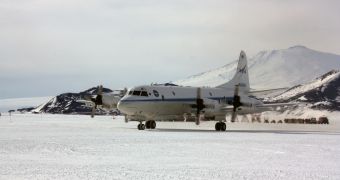Officials at NASA say that all the scientists and engineers associated with Operation IceBridge have arrived in Antarctica, at the McMurdo Station. This facility will be the base for the 2013 leg of the long-term climate-monitoring operation. The special aircraft to be used during this study has already been prepped, and is scheduled to begin its daily flights soon.
NASA will use the US National Science Foundation (NSF) installation near the South Pole as a base for its highly modified P-3 aircraft. This asset is outfitted with a variety of sensors and scientific instruments, all of which will be used to assess properties of the Antarctic ice sheets and their evolution over time.
The P-3 airplane was delivered to the South Pole from its base at the Wallops Flight Facility, in Virginia. Over the past few years, it has traveled to several destinations around the world, including the Arctic and South America. Last year, its flights were based out of Punta Arenas, Chile.
The main purpose of the IceBridge mission is to act as a “bridge” between the former Ice, Cloud, and land Elevation Satellite (ICESat) and an upcoming replacement for the mission, scheduled to be launched in a few years.
With the P-3 aircraft, NASA ensures the continuity of ice data for statistical purposes, over the most important ice-covered areas of the world, including both poles and Greenland. The IceBridge mission is scheduled to last from 2009 to 2016, when ICESat-2 should launch.
This year's flights will survey critically important portions of Antarctica, and will occur every day until November 26. “Flying from Antarctica will allow us to survey areas that had been unreachable from Chile,” explains IceBridge mission scientist Michael Studinger.
“There are many scientifically important areas we can now reach from McMurdo,” adds the expert, who is based at the NASA Goddard Space Flight Center (GSFC), in Greenbelt, Maryland.
The P-3 aircraft features a suite of scientific instruments that can collect very precise data. Some of these instruments include laser altimeters, radars, and cameras. Additional sensors for gravity and magnetic field measurements are also installed on the aircraft.
According to a NASA statement, this year's IceBridge mission will be focused on areas including the Ross Sea, and the Ross Ice Shelf. The tools aboard the P-3 aircraft have the capability to peer through the ice sheet, and figure out how the ices interact with the solid ground underneath.

 14 DAY TRIAL //
14 DAY TRIAL //